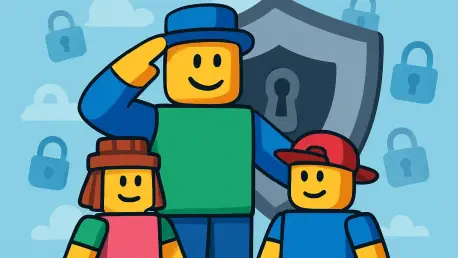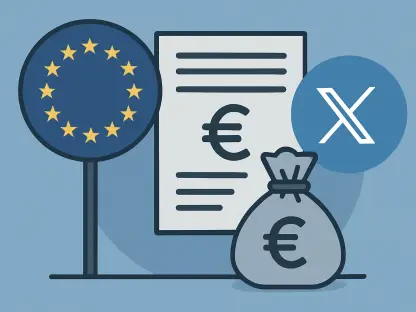In an era where online platforms are under intense scrutiny for child safety, Roblox has emerged as a focal point due to its massive user base, with nearly 40% of its community under the age of 13. This popular gaming platform, a virtual playground for millions of young users, faces significant challenges in protecting its youngest players from potential risks posed by interactions with older individuals. Recent legal pressures and public concerns have pushed the company to implement innovative safety measures, including facial age verification and structured age groupings. These updates aim to create a safer digital environment by limiting inappropriate contact and tailoring content to specific age ranges. However, as these tools roll out, questions linger about their effectiveness in mitigating risks without compromising user privacy or introducing new vulnerabilities. This article delves into the specifics of Roblox’s latest safety overhaul, exploring how these changes could reshape the platform’s approach to protecting children in a complex online landscape.
1. Unveiling Roblox’s Latest Safety Innovations
Roblox has introduced a comprehensive safety update that incorporates facial age verification as a cornerstone of its efforts to protect younger users. This process requires individuals to confirm their age either through a government-issued ID or by submitting a short video selfie analyzed via a Facial Age Estimation tool. Managed by a third-party service provider, Persona, this system is designed to categorize users accurately into age-specific groups. Importantly, Roblox has emphasized that all images used for verification are deleted immediately after processing to address potential privacy concerns. This step is crucial in reassuring families about the security of personal data during these checks. While the verification is initially optional in many regions, plans are in place to make it mandatory for certain features and markets, with a gradual rollout expected globally. This phased approach allows the platform to refine the system based on early feedback and regional requirements, ensuring a balance between safety and accessibility for all users.
The significance of these changes lies in their potential to redefine how online platforms manage user interactions across diverse age demographics. By implementing mandatory checks in specific contexts, Roblox aims to prevent younger players from encountering inappropriate content or unsolicited contact from adults. The collaboration with Persona adds a layer of expertise in handling sensitive data, though it also raises questions about the reliability of third-party systems in maintaining strict privacy standards. As the rollout progresses, the platform will need to address varying legal and cultural expectations across different countries to ensure compliance and user trust. This safety update represents a proactive response to growing calls for stronger protections in virtual spaces frequented by children, setting a precedent for how technology can be leveraged to create safer online communities. The focus now shifts to how effectively these measures can be integrated without disrupting the user experience or introducing unintended risks.
2. Understanding the Mechanics of Age Categories
Roblox’s new age grouping system sorts verified accounts into six distinct categories: under 9, 9–12, 13–15, 16–17, 18–20, and 21+. This structure is designed to limit interactions between users of significantly different ages, thereby reducing the risk of harmful contact. Under this system, users can communicate within their own age band and with those in the immediate band above, but any interaction beyond these limits requires a “Trusted Connection.” This feature is intended to support real-life relationships, such as those between siblings, while preventing unsolicited outreach from strangers. For instance, a 12-year-old can view profiles of users aged 13–15 but cannot engage with them directly, and those aged 16 and above are entirely restricted from chatting with younger users unless a trusted link is established. This framework aims to shrink the social pool available for potential predatory behavior, addressing a key concern in online safety for children.
The practical implications of these restrictions are significant in curbing opportunities for grooming and other forms of exploitation on the platform. By enforcing strict boundaries on who can interact with whom, Roblox minimizes the chances of younger users being approached by individuals outside their age-appropriate circle. The Trusted Connection mechanism adds an additional safeguard by requiring mutual consent for cross-group communication, ensuring that such interactions are based on genuine, known relationships rather than random or malicious intent. However, the success of this system depends on user compliance and the platform’s ability to monitor and enforce these rules effectively. As age bands narrow the scope of social engagement, they create a controlled environment that prioritizes safety over unrestricted connectivity, reflecting a broader shift in how digital spaces are adapting to protect vulnerable populations from online risks.
3. Advantages for Developers Through Age Segmentation
For developers creating content on Roblox, the introduction of age-specific bands offers valuable opportunities to tailor experiences to targeted demographics. This segmentation allows for the customization of games and virtual environments to suit the maturity and interests of different age groups, ensuring that content remains appropriate and engaging. Developers can now specify the intended audience for their creations, which in turn helps the platform adjust moderation settings to match the needs of each age category. This targeted approach reduces the likelihood of younger users being exposed to material that may not be suitable for their developmental stage, fostering a safer and more relevant user experience. By aligning content with age bands, developers contribute to a more structured digital ecosystem where safety and enjoyment can coexist, addressing long-standing concerns about inappropriate content accessibility on gaming platforms.
Moreover, age segmentation provides developers with clearer insights into their audience, enabling more effective design and interaction strategies. With the ability to focus on specific age ranges, creators can fine-tune gameplay mechanics, themes, and language to resonate with their intended users, enhancing engagement while adhering to safety protocols. The moderation adjustments tied to age bands also mean that developers can rely on the platform to enforce stricter controls where needed, reducing the burden of managing user interactions manually. This system not only benefits players by limiting exposure to unsuitable content but also empowers developers to build trust with parents and regulators by demonstrating a commitment to child safety. As Roblox continues to refine these tools, developers will play a pivotal role in shaping a safer virtual landscape through thoughtful design and adherence to age-appropriate guidelines.
4. Navigating Privacy and Accuracy Challenges
The use of facial age estimation in Roblox’s verification process, while innovative, introduces notable challenges related to accuracy and fairness. Unlike traditional identity checks that rely on documented proof, this method analyzes a video selfie to predict a user’s likely age without storing personal identification data in a database. However, independent studies, such as those conducted under NIST’s Face Recognition Vendor Test program, have highlighted inconsistencies in performance across different ages, genders, and skin tones. Such variations raise concerns about the potential for misclassification, which could unfairly restrict or grant access to certain platform features. Ensuring that the technology operates equitably for all users is critical to maintaining trust and avoiding discrimination, particularly when access to social interactions and content is at stake. Roblox must address these technical limitations to prevent unintended consequences in its safety framework.
Beyond accuracy, privacy remains a central issue in the deployment of facial recognition technology for age verification. Roblox has assured users that all media submitted for checks is deleted after processing by its third-party partner, Persona, to mitigate risks associated with biometric data storage. Nevertheless, privacy advocates continue to seek transparency regarding data retention policies, the nature of information shared between Roblox and Persona, and safeguards against potential misuse or function creep. Regulatory bodies worldwide, including the FTC in the United States and data protection authorities in the UK and EU, are increasingly focused on ensuring that age assurance methods respect user privacy while achieving their protective goals. Roblox will be closely scrutinized to ensure compliance with these evolving standards, balancing the need for robust safety measures with the imperative to protect personal information from exploitation or breach.
5. Assessing the Impact of Safety Enhancements
Roblox’s new safety measures, including age stratification and interaction constraints, are designed to create significant barriers against inappropriate contact between younger and older users. By limiting communication to within specific age bands and requiring Trusted Connections for exceptions, the platform reduces the likelihood of a child aged 9–12 receiving unsolicited messages from someone much older. Organizations like the National Center for Missing & Exploited Children have long warned that such unsolicited outreach is often a precursor to online enticement, making these restrictions a critical step forward. Additionally, the ability to target experiences to specific age groups ensures that content aligns with the developmental needs of users, further minimizing exposure to harmful material. These updates represent a meaningful attempt to address systemic risks in large-scale online environments where millions of users interact daily.
However, these measures are not without limitations, as determined individuals may still find ways to circumvent safeguards. Public lobbies remain potential spaces for predators to initiate contact, and conversations can be moved to external apps beyond Roblox’s control. Misclassification of ages, shared device usage, or misuse of Trusted Connections by accepting links from unknown individuals also pose challenges. For these protections to be truly effective, they must be supported by strict default settings, responsive reporting mechanisms, and active moderation—both human and automated. Swift enforcement against repeat offenders is equally essential to deter exploitative behavior. With over 70 million daily active users, including a substantial youth demographic, the scale of the platform amplifies these risks, while legal pressures from states like Texas, Louisiana, and Kentucky underscore the urgency of robust safety improvements.
6. Empowering Parents and Developers with Actionable Steps
Parents play a vital role in enhancing child safety on Roblox by taking proactive steps to secure their children’s accounts and foster safe online habits. Reviewing and adjusting account settings to restrict who can chat or send friend requests is a fundamental measure to limit unwanted interactions. Enabling two-factor authentication adds an extra layer of security to prevent unauthorized access. Engaging in open conversations about the importance of Trusted Connections helps children understand who they should connect with and why these links matter. Encouraging kids to keep all communication within the platform, while utilizing in-game ratings and content filters, further reduces exposure to risks. Finally, parents should be vigilant in reporting any suspicious behavior immediately, ensuring that potential threats are addressed promptly. These actions empower families to create a safer digital experience while complementing the platform’s built-in protections.
Developers, on the other hand, have a unique opportunity to contribute to safety by aligning their creations with Roblox’s age-specific guidelines. Tagging experiences to match the intended age band ensures that content reaches the appropriate audience without risking exposure to younger users. Avoiding mechanics that enable private or hidden communication within games is critical to preventing misuse. Implementing session-level protections, such as default muting for new connections and proactive moderation prompts, adds another layer of safety during user interactions. Transparency about data usage and safety design also builds trust with players and their families. By adopting these practices, developers can help reinforce Roblox’s safety framework, ensuring that their contributions to the platform prioritize the well-being of all users, especially the youngest and most vulnerable among them.
7. Reflecting on the Path Forward for Child Protection
Looking back, Roblox took bold steps by integrating facial recognition and age-based groupings into its safety protocols, marking a pivotal moment in the platform’s commitment to protecting children online. These initiatives mirrored a wider industry shift toward verifiable age assurance, responding to heightened demands for secure virtual spaces. The focus on limiting interactions across age disparities and customizing content demonstrated a proactive stance against the risks of grooming and inappropriate exposure. Success, however, relied heavily on the precision of the technology, stringent privacy measures, and consistent enforcement of rules. While these tools lowered immediate risks, their long-term impact depended on how diligently loopholes were addressed. Moving forward, sustained collaboration between platforms, regulators, parents, and developers remains essential to refine these safeguards. Prioritizing ongoing innovation and transparency will be key to ensuring that digital environments evolve in step with emerging threats, ultimately securing a safer future for young users.









